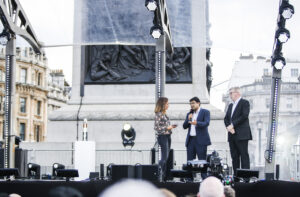Ross Brawn shares his views on the collaboration of F1 and digital transformation in this guest blog.
Ross Brawn wears big shoes – and that’s not just because he’s a giant of a man. The Managing Director of Motorsports at Formula 1 is a genuine legend in the sport.
As a master technical director and team principal, he won multiple world championship titles at teams including the eponymous Brawn GP, while his partnership with Michael Schumacher at Benetton and Ferrari turned the German driver into one of the greatest motorsport has ever seen.
In his new role, Ross’s job is to oversee the sporting and technical regulations of F1, with the aim of recapturing its authenticity and making it the most entertaining sport it can be. If he’s successful, no single team will be able to do exactly what Ross did to make a name for himself: dominate Formula 1. Here’s what the man himself has to say about the challenges he expects to face.
Hacks and tracks
My career in motorsports spans almost 40 years but I’m still amazed by how far we’ve come.
When I started in the 1970s there were lots of amusing ‘hacks’ we used to gather the information we needed to get the cars running at their full potential. For example, to know how far the suspension was travelling we used to put O rings on the shafts of the dampers and hope that would tell us how far it had moved.

Lewis soaking up the atmosphere at the 2019 Australian GP
Modern teams would be aghast at such an unscientific approach, but at the time these ad-hoc solutions were the best we could do. Today, there are thousands of channels of data collection on a modern F1 car, generating valuable information that is fed back to the teams with the aim of improving safety and performance.
“But it’s not just the technology in the paddock that’s changed beyond all recognition. The way we communicate with fans has been completely transformed as well.”
Putting fans first
In my current role, I’m often asked about how Formula 1 should grow its fanbase. Most traditional sports are witnessing a decline in engagement, but I’m glad to note that F1 has arrested the slide. In many markets, it’s actually reversing.
Back in the day, Formula 1 was a high-risk sport pushing the slightly hazy boundaries of engineering, so the average fan was either a technology geek or an adrenaline junkie. But according to a survey we conducted recently, there are now six distinct segments of fans.
“As well as the traditional motorsport enthusiasts and speed freaks, whose attention flits between the track action and the myriad of numbers and charts on the television feed, we have a whole spectrum of fans with varying degrees of obsession.”
There are the Excitables who are keen to travel to the races and purchase their favourite driver’s merchandise, the Purists who wish to delve deep into the technology, the Sociables who follow the track action and tweet about overtakes and crashes, and Habituals, Peripherals and Incidentals on the fringes.

Ross with Mehul Kapadia of Tata Communications at F1 Live in London
Combined, they added up to 490 million fans who watched Formula 1 on television through the 2018 season, and another 4 million who attended the races in person. That’s a staggering jump in figures from when I started.
The commercial implications of keeping the entire set engaged are huge but there is no one-size-fits-all approach to doing so. We need to understand the broad segments of fans who want to consume specific branches of data and serve their needs effectively.
This challenge of customisation has now spurred technology companies like Tata Communications, among others, to come and change the landscape. Last year, we asked fans to share their vision of ‘My F1’ in the Tata Communications F1 Innovation Prize. As a judge, I had a fantastic time reading the entries.
The art of balance
There is so much information available to the teams and to the fans, we have reached a stage where we must seek a balance.
This is ingrained in Formula 1 technicians, because to create a successful car you must increase performance without compromising on reliability, while also meeting all the technical specifications. The team that can consistently manage to extract the most performance out of a design through a long season will take home the championship.
With the wealth of platforms, channels and information at our disposal, the same approach must be taken to engaging fans. Linear television feeds are constantly improving in terms of the graphics and the information we can give to the fans, but we must be careful not to crowd it too much.
“There are always layers and new technologies that we can add to cater to fans who have different types of interest, but you must be careful not to alienate the traditional fans while engaging the new ones.”
 With technology revolutionising the way content is consumed, though, there is potential for disruption at every step. Everything deserves a rethink: how the teams build the car; how the cars race on track; how the program feed is produced and distributed; how the sponsors align their objectives with the sport; and how fans respond and engage to the entire spectacle. Many fans suggest we shorten the race weekend but that would mean a lower overall attendance and viewership, hurting sponsors who enable us to put on the show.
With technology revolutionising the way content is consumed, though, there is potential for disruption at every step. Everything deserves a rethink: how the teams build the car; how the cars race on track; how the program feed is produced and distributed; how the sponsors align their objectives with the sport; and how fans respond and engage to the entire spectacle. Many fans suggest we shorten the race weekend but that would mean a lower overall attendance and viewership, hurting sponsors who enable us to put on the show.
F1 is looking to go to new territories and grow the global fanbase, but at the same time retain the European core audience. I’m sure corporations face similar challenges – growing the market while retaining their core base. There are no definite answers.
Whatever happens I anticipate very exciting times for the sport in the near future. With the pace of technology advancement and innovation in content production and distribution, I am sure we will make the spectacle even more spectacular. It’s just a matter of finding the right balance.
Discover what untapped opportunities in digital transformation bring to fan experience.
Tata Communications was the Official Connectivity Provider of Formula 1® between 2012 and 2019. Tata Communications was also the Official Managed Connectivity Supplier to Mercedes-AMG Petronas Motorsport, and Official Digital Transformation Partner to ROKiT Williams Racing until the end of the 2019 season.
Transformational Hybrid SolutionsOur cloud-enablement services offer the best performance on your traffic-heavy websites or mission-critical applications.
Core NetworksTata Communications™ global IT infrastructure and fibre network delivers the resources you need, when and where you need them.
Network Resources
Unified Communications As A ServiceBreak the barriers of borders efficiently and increase productivity with Tata Communications’ UC&C solutions.
Global SIP ConnectEmpower your business with our SIP network and witness it grow exponentially.
InstaCC™ - Contact Centre As A ServiceCloud contact centre solutions for digital customers experience and agent productivity.
Unified Communication Resources Case studies, industry papers and other interesting content to help you explore our unified communications solution better.
IoT SolutionsThe Internet of Things is transforming the way we experience the world around us for good. Find out more about our Internet Of Things related solutions here.
Mobility SolutionsTata Communications’ mobility services enable your enterprise to maintain seamless communication across borders, with complete visibility of cost and usage.
Mobility & IoT Resources
Multi-Cloud SolutionsWith enterprises transitioning to a hybrid multi-cloud infrastructure, getting the right deployment model that yields ROI can be a daunting task.
Cloud ComplianceCompliant with data privacy standards across different countries and is also designed to protect customers’ privacy at all levels.
IZO™ Cloud Platform & ServicesIZO™ is a flexible, one-stop cloud enablement platform designed to help you navigate complexity for more agile business performance.
Managed Infrastructure ServicesIntegrated with our integrated Tier-1 network to help your business grow efficiently across borders.
Cloud PartnersWe support a global ecosystem for seamless, secure connectivity to multiple solutions through a single provider.
Cloud Resources
Governance, Risk, and ComplianceRisk and Threat management services to reduce security thefts across your business and improve overall efficiencies and costs.
Cloud SecurityBest-in-class security by our global secure web gateway helps provide visibility and control of users inside and outside the office.
Threat Management - SOCIndustry-leading threat-management service to minimise risk, with an efficient global solution against emerging security breaches and attacks.
Advanced Network SecurityManaged security services for a predictive and proactive range of solutions, driving visibility and context to prevent attacks.
Cyber Security ResourcesCase studies, industry papers and other interesting content to help you explore our securtiy solution better.
Hosted & Managed ServicesTata Communications provide new models for efficient wholesale carrier voice service management. With our managed hosting services make your voice business more efficient and better protected
Wholesale Voice Transport & Termination ServicesYour long-distance international voice traffic is in good hands. End-to-end, voice access & carrier services which includes voice transport and termination with a trusted, global partner.
Voice Access ServicesTata Communication’s provide solutions which take care of your carrier & voice services, from conferencing to call centre or business support applications.
Carrier Services Resources
CDN Acceleration ServicesOur CDN Web Site Acceleration (WSA) solution helps deliver static and dynamic content, guaranteeing higher performance for your website.
CDN SecuritySafeguard your website data and customers’ information by securing your website from hacks and other mala fide cyber activities.
Video CDNDeliver high-quality video content to your customers across platforms – website, app and OTT delivery.
CDN Resources
Elevate CXIncrease customer satisfaction while empowering your service team to deliver world-class customer experience and engagement.
Live Event ServicesTata Communications’ live event services help battle the share if eyeballs as on-demand video drives an explosion of diverse content available on tap for a global audience.
Media Cloud Infrastructure ServicesTata Communications’ media cloud infrastructure offers flexible storage & compute services to build custom media applications.
Global Media NetworkTata Communications’ global media network combines our expertise as a global tier-1 connectivity provider with our end-to-end media ecosystem.
Use CasesUse cases of Tata Communications’ Media Entertainment Services
Remote Production SolutionsMedia contribution, preparation and distribution are highly capital-intensive for producers of live TV and video content, and their workflows are complex.
Media Cloud Ecosystem SolutionsThe Tata Communications media cloud infrastructure services offer the basic building blocks for a cloud infrastructure-as-a-service.
Global Contribution & Distribution SolutionsTata Communications’ global contribution and distribution solution is built to reduce capital outlay and grow global footprint.
Satellite Alternative SolutionsAs more and more consumers choose to cut the cord & switch to internet-based entertainment options, broadcasters are faced with capital allocation decisions.
LeadershipA look into the pillars of Tata communications who carry the torch and are living embodiment of Tata’s values and ethos.
Culture & DiversityHere at Tata Communications we are committed to creating a culture of openness, curiosity and learning. We also believe in driving an extra mile to recognize new talent and cultivate skills.
OfficesA list of Tata Communications office locations worldwide.
FAQCheck out our FAQs section for more information.
SustainabilityOur holistic sustainability strategy is grounded in the pillars of People, Planet and Community with corporate governance at the heart of it.
BoardHave a look at our board of members.
ResultsFind out more about our quarterly results.
Investor PresentationsFollow our repository of investor presentations.
FilingsGet all information regarding filings of Tata communications in one place.
Investor EventsAll investor related event schedule and information at one place.
GovernanceAt Tata, we believe in following our corporate social responsibility which is why we have set up a team for corporate governance.
SharesGet a better understanding of our shares, dividends etc.
SupportGet all investor related contact information here.


